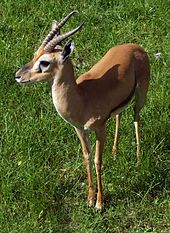Eudorcas
| Eudorcas | |
|---|---|

| |
| Thomson's gazelle - Serengeti region of Kenya and Tanzania | |
| Scientific classification | |
| Domain: | Eukaryota |
| Kingdom: | Animalia |
| Phylum: | Chordata |
| Class: | Mammalia |
| Order: | Artiodactyla |
| Family: | Bovidae |
| Subfamily: | Antilopinae |
| Tribe: | Antilopini |
| Genus: | Eudorcas Fitzinger, 1869 |
Eudorcas is a genus of antelope; the species are commonly called gazelles. Eudorcas was originally considered a subgenus of the genus Gazella but has since been elevated to generic status.[1] The four species within the genus Eudorcas are:
- Genus Eudorcas[1]
- Mongalla gazelle, E. albonotata
- Red-fronted gazelle, E. rufifrons
- E. r. kanuri
- E. r. laevipes
- E. r. rufifrons
- E. r. tilonura, Heuglin's gazelle[2]
- Red gazelle, E. rufina
- Thomson's gazelle, E. thomsonii
- E. t. nasalis
- E. t. thomsonii
Social structure and behavior

The social structure of gazelles consists of several types of groups. Male gazelles are territorial throughout their adult lives, though not usually before two to three years of age. During the nonterritorial periods, males usually spend their time in bachelor groups or as part of a mixed herd. Likewise, females will form migratory female groups that travel through the males' territories. As the female groups pass through, the territorial males will try to herd them to prevent them from leaving. Adult males with adjoining territories will engage in combat several times a day, fighting with their horns to establish dominance and the boundaries of their territories. In this way, the accepted boundaries of the territory can change on a daily basis. If a lone male, a bachelor group, or in some cases even an adolescent male fawn of a female gazelle should be passing through a territorial male's region, the male will chase the offender out of his territory. Interestingly, this territoriality does not extend to males of other species.
The territory of a Thomson's gazelle and several other types of ungulates may overlap with no problem whatsoever. Occasionally, a Thomson's gazelle and a zebra or other ungulate will even appear to enjoy one another's company with great sociability. A noticeable behavior of Thomson's gazelles is their bounding leap, known as stotting or pronking, used to startle predators and display strength. Female Thomson's gazelles give birth to single fawns after a five- to six-month gestation period. They are unusual among ungulates in that they can give birth twice yearly, rather than just once. The fawn spends the first few months hiding in the grasses, with the mother coming to feed it daily. When the fawn can take care of itself, it joins the herd. Half of all the fawns born will be lost to predators before reaching adulthood.[citation needed]
References
- ^ a b Eudorcas, MSW3
- ^ Eudorcas rufifrons ssp. tilonura, IUCN
